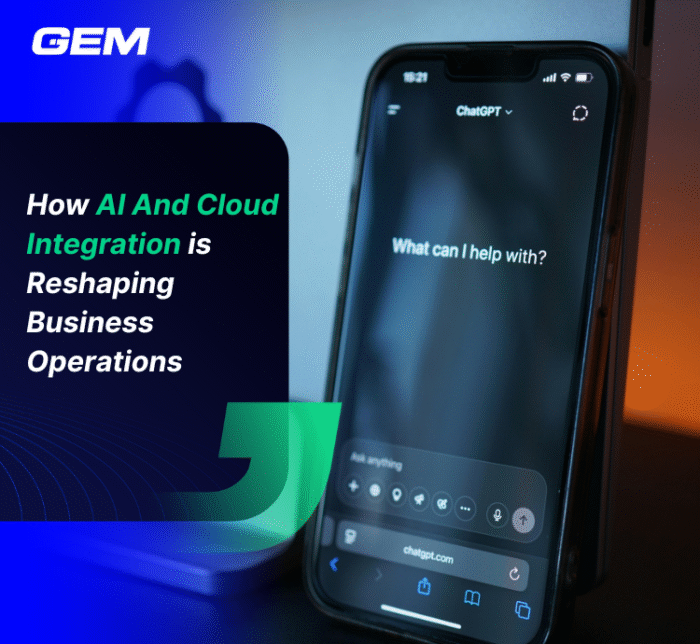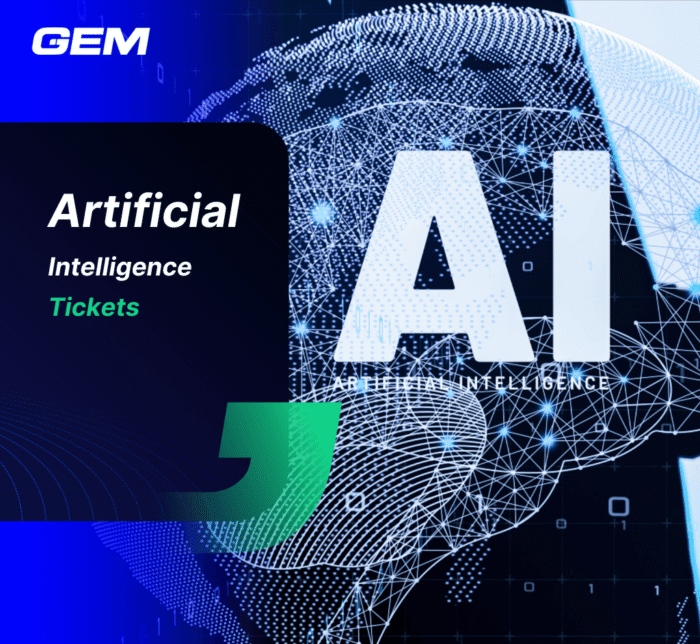Contents
- AI Use Cases in Marketing and Customer Experience
- AI Use Cases in Operations and Supply Chain Management
- AI Use Cases in Finance and Risk Management
- AI Use Cases in Healthcare and Life Sciences
- AI Use Cases in Manufacturing and Industrial Processes
- Closing remark
- Are you looking for a trustworthy AI development company?
Artificial intelligence (AI) has become a powerful force for transformation that is reshaping numerous aspects of society. In this blog, we delve into real-world use cases where AI is making a tangible impact, spotlighting industries like Marketing and Customer Experience, Operations and Supply Chain Management, Finance and Risk Management, and more.
AI Use Cases in Marketing and Customer Experience
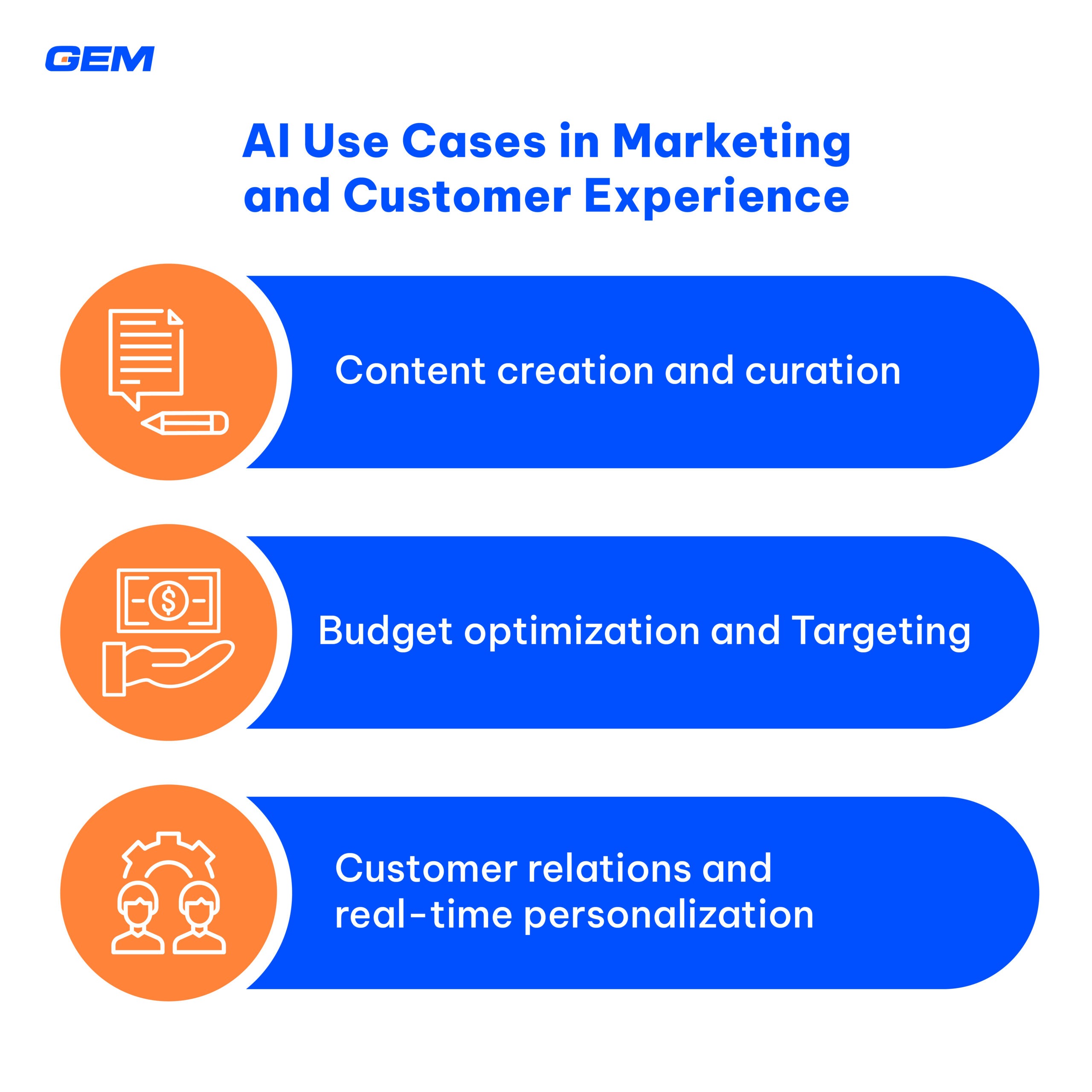
Content creation and curation
AI has been a game-changer for content creation by assisting and enhancing various aspects of the content generation process. AI-powered tools can generate personalized written content, such as articles, reports, and product descriptions, by analyzing data, trends, and user preferences. AI algorithms can also summarize, extract key information and generate concise summaries to help content creators grasp the main idea of lengthy articles, reports, or documents.
Furthermore, AI-powered grammar and style checkers, such as Grammarly, help writers improve the quality of their content by identifying and suggesting corrections for grammar, spelling, punctuation, and writing style. The application of AI tools is not only for textual content. AI can also create images, graphics, and videos using generative algorithms, like Midjourney and FlexClip, making it easier to produce multimedia-rich content.
Along with content creation, AI also leverages content curation and organization by helping marketers sift through vast amounts of information and present it in an organized and meaningful way. AI algorithms can continuously monitor and analyze a wide range of sources, including websites, social media, news feeds, and more, to discover new and relevant content based on specified keywords, topics, or user preferences. In addition, a digital tool like that can automatically categorize and group similar content together, creating clusters or categories based on themes, subjects, or keywords, which helps curators organize content for easier access and navigation.
Budget optimization and Targeting
According to a 2022 report by Annuitas Group, marketing automation users experience a 451% increase in qualified leads. With AI’s assistance, marketers can target the right audience and optimize advertising expenditures. with their data-crunching ability, AI systems process vast information to predict market trends and customer behavior.
In addition, AI optimizes budget by continually fine-tuning campaigns, automating A/B testing, measuring ROI and making suggestions on how you can improve the campaign to keep it competitive.
IBM Watson stands out as a widely used AI marketing tool, offering marketers a powerful platform for refining their campaigns. By leveraging Watson’s AI capabilities, marketers can delve into customer data analysis and recognize key patterns. This insightful analysis empowers marketers to craft highly personalized campaigns.
Customer relations and real-time personalization
Customer experience is at the heart of marketing, and AI-powered tools can assist marketers in giving visitors the best experience to convert them into leads. AI engines yield useful insights into customer behavior and preferences, which enable marketers to deliver highly personalized marketing messages, services, and product recommendations in real-time.
AI-powered chatbots provide round-the-clock customer support, while email marketing benefits from optimized messaging (customer behavior, preferences, historical engagement and timing of email delivery). For instance, Camping World used Arvee, a messenger chatbot available 24/7, powered by watsonx Assistant, to aid sales and customer care staff. Since it had its own chatbot platform, live agents could reply to more sophisticated discussions, reducing response times and increasing agent productivity. The drop in conversation failures has reduced, customer engagement has risen by 40%, and overall efficiency has seen a 33% improvement.
AI Use Cases in Operations and Supply Chain Management
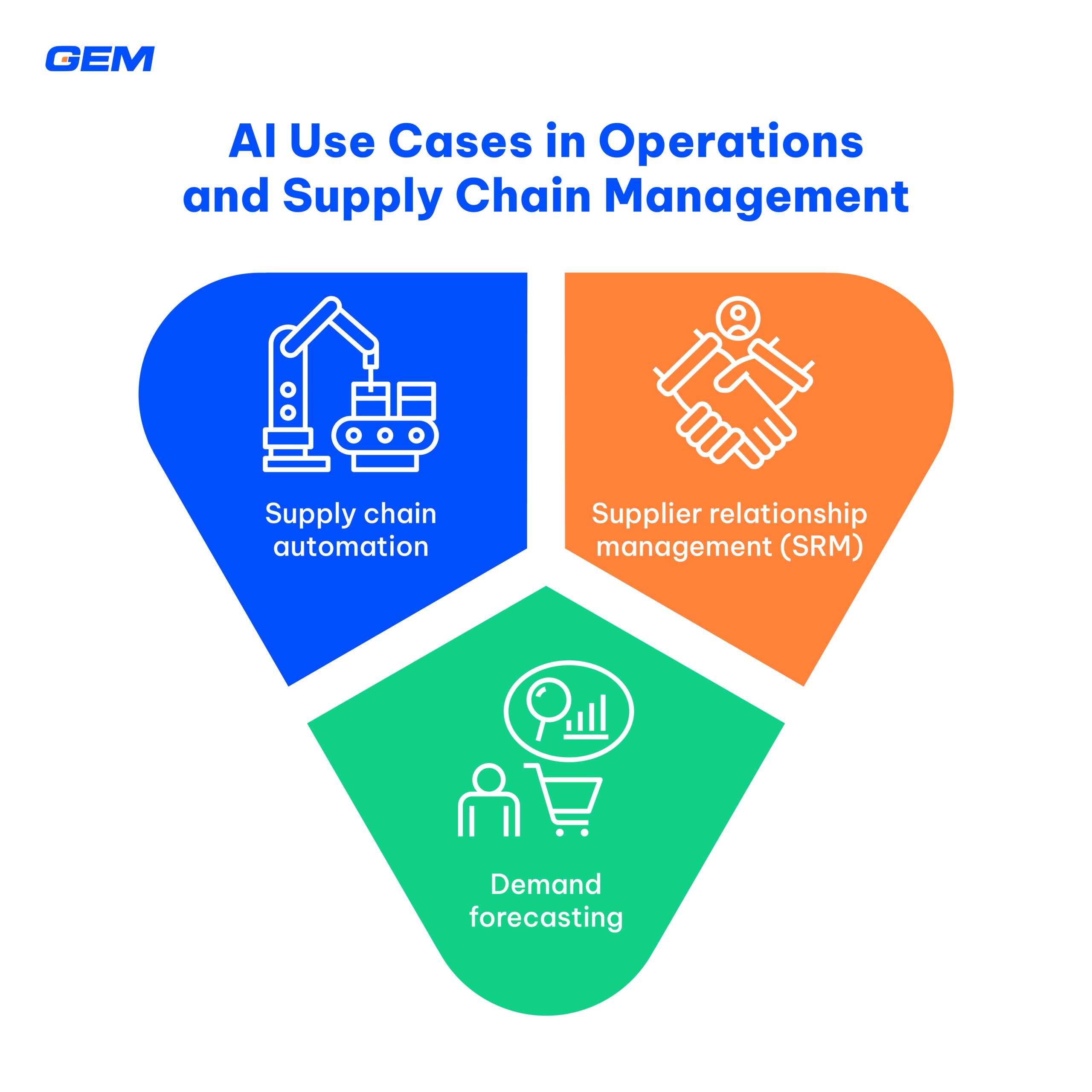
Supply chain automation
The advent of automation technologies, such as warehouse robots, Robotic Process Automation (RPA), and digital workers, has streamlined repetitive and error-prone tasks in supply chain management.
One notable area where automation excels is in back-office tasks, particularly document processing. Cognitive automation, in combination with conversational AI and RPA, enables the swift and accurate handling of document-related tasks. This synergy ensures that routine paperwork is efficiently managed, reducing human error and freeing up valuable human resources for more complex tasks.
The application of AI-powered technologies also extends to warehouse management. Collaborative robots, or “cobots,” work alongside human workers, automating tasks like inventory movement and reducing the risk of workplace injuries. Therefore, they play a crucial role in enhancing efficiency, productivity, and safety within warehouse operations.
In addition, AI also contributes to quality control and inventory management through computer vision (CV) systems. These systems inspect products for defects and maintain precise inventory records, ensuring that products meet the defined standards and reducing the likelihood of overstock or stockouts.
Demand forecasting
AI-powered solutions may dramatically improve the accuracy of demand forecasting. By examining historical demand, supply data and trends, AI-powered technologies can assist in determining ideal inventory levels, which helps businesses avoid overproduction and storage expenses. AI-powered forecasting systems can also aid in the customization of fulfillment operations based on region-specific requirements.
In addition, AI can help solve a major pain point in supply chain management – the bullwhip effect. This effect happens when small variations at one end of the supply chain are magnified as they flow upstream/downstream. By integrating data from consumers, suppliers, manufacturers, and distributors, AI-powered forecasting solutions can help decrease demand and supply swings to regulate bullwhips.
Supplier relationship management (SRM)
AI fosters more consistent and efficient supplier relationship management (SRM). AI-enabled SRM software, for example, enables supplier selection based on cost, buying history, sustainability, etc. AI-powered systems may also assist in tracking, analyzing, and ranking supplier performance data.
Furthermore, AI-powered solutions like RPA automate typical supplier activities such as invoice sharing and payment reminders. Therefore, undesirable delays can be avoided – for example, forgetting to make a payment to a vendor can lead to detrimental impacts on the overall process of production and shipment.
AI Use Cases in Finance and Risk Management
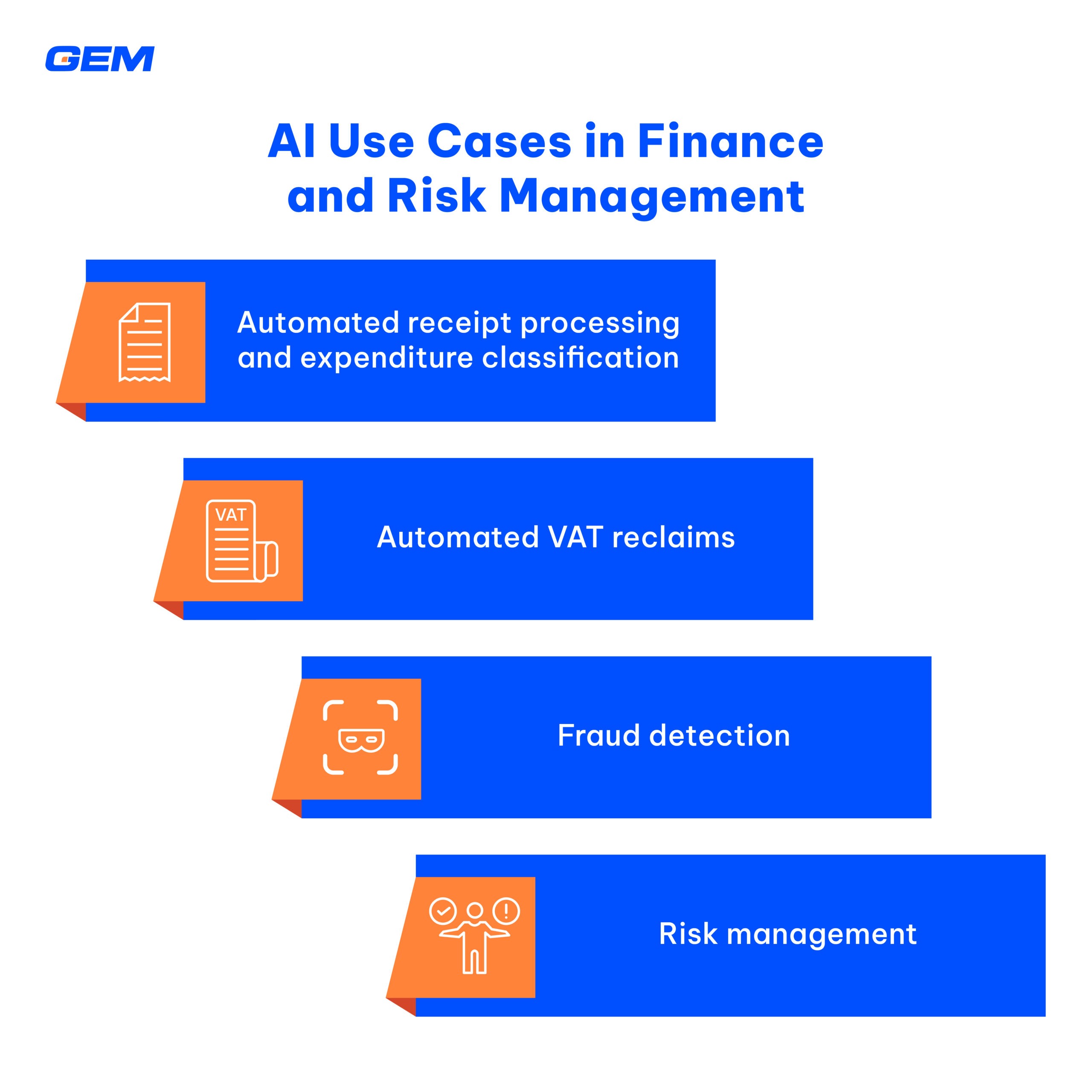
Automated receipt processing and expenditure classification
AI is a valuable tool in financial management, especially for optimizing receipt processing and expenditure categorization. It does this by using OCR (Optical Character Recognition) technology to efficiently extract invoice data, followed by AI algorithms that interpret and categorize expenses based on cost centers and expenditure categories. AI also scrutinizes data for anomalies and policy violations, adding an extra layer of compliance checks. This replaces manual data entry, saves time, reduces errors, and provides real-time expenditure tracking for finance teams.
Automated VAT reclaims
In reclaiming VAT, AI identifies the VAT (Value Added Tax) amounts eligible for recovery within each expense category. AI engines collect data from multiple sources, including emails, digital receipts, and invoices to precisely calculate the amount of VAT eligible for recovery. They can also be used to identify any inconsistencies or errors. Therefore, financial & accounting professionals can save time considerably while achieving highly accurate outputs with their work.
Fraud detection
According to Juniper Research, global spending on AI-powered financial fraud detection and prevention strategies is projected to surpass $10 billion in 2027, up from $6.5 billion in 2022.
The report anticipates a 57% growth, attributing this trend to increasing sophistication among fraudsters. To combat this, AI can be used to evaluate massive datasets and detect illicit behaviors such as credit card fraud or money laundering.
When it comes to the spend management process, AI detects fraudulent invoices, duplicate payments, and spending that violate corporate policies. In addition, machine learning algorithms can learn from prior examples of fraud and uncover new patterns that rule-based systems may have overlooked.
Risk management
Finance AI analyzes the risks associated with financial transactions such as loans and investments by evaluating massive volumes of data, allowing financial organizations to make more informed decisions.
In comparison to manual, human-driven methods, AI technology is far more efficient, accurate, and consistent. It can find patterns and links that people may miss, resulting in more accurate insights.
AI Use Cases in Healthcare and Life Sciences
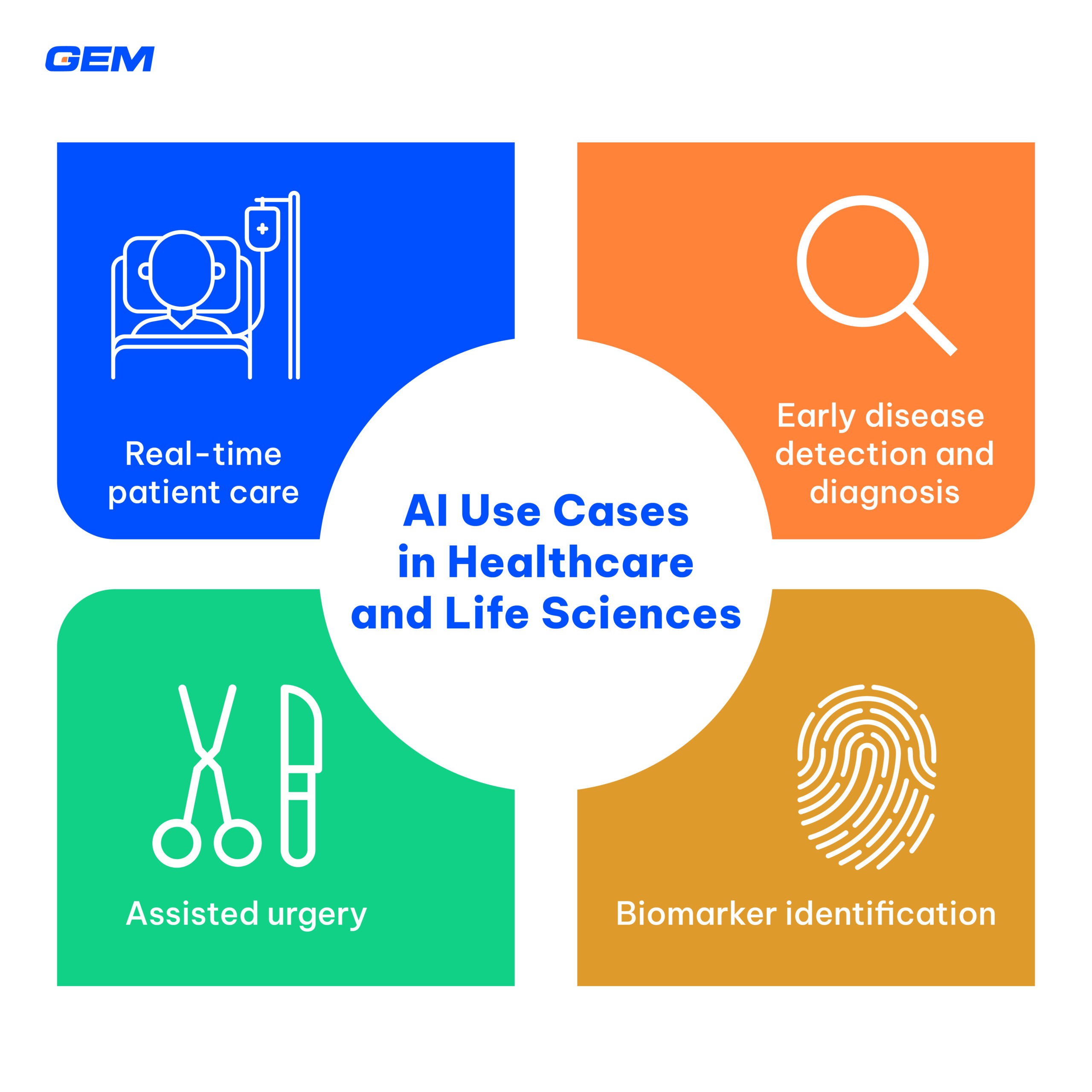
Real-time patient care
Chatbots equipped with Natural Language Processing (NLP) have revolutionized patient care by reducing the need for physical visits to the doctor. In the realm of telemedicine, AI plays a pivotal role in automating diagnoses and prescription deliveries based on a patient’s symptoms, past medical history, prescription records, and family medical background.
AI, furthermore, provides easy, precise, and reliable real-time patient monitoring. Through AI-powered Remote Patient Monitoring (RPM) systems, healthcare providers can continuously track vital signs, medication adherence, and various critical health indicators. These systems are designed to alert healthcare professionals promptly at the first signs of potential issues, preventing them from escalating into more severe problems.
Explore more: AI in Healthcare: Transforming Patient Care and Health Management
Early disease detection and diagnosis
AI takes on a pivotal role in the early detection of illnesses, leveraging its ability to meticulously analyze patient records, smart device data, etc. to pinpoint subtle patterns and irregularities that could indicate the presence of a disease.
Furthermore, AI empowers healthcare professionals by presenting them with well-organized lists of potential diagnoses, accompanied by supporting data and probability estimations, hence narrowing down the range of possible diagnoses. In a 2017 study focused on patients at risk of stroke, AI algorithms analyzed symptoms and genetic history to generate early detection. The study demonstrated an 87.6% accuracy in diagnosis and prognosis, enabling timely treatment and predicting patients’ future stroke risk.
Assisted surgery
In surgical procedures, AI enables effective preoperative planning and provides intraoperative assistance. In preoperative planning, AI leverages historical data, including medical records and past surgical methods, to suggest a suitable surgical approach. For example, recent research into AI-based preoperative planning for knee arthroplasty surgery revealed substantial improvements in procedure efficiency. The AI-generated plan exhibited remarkable precision in implant sizing, surpassing the manufacturer’s default plan. Specifically, femoral and tibial implant sizes were correct in 82.2% and 85.0% of cases, respectively, compared to the manufacturer’s plan, which achieved accuracies of 68.4% and 73.1%, as validated against surgeon-approved plans.
Another critical application of AI in surgery is AI-enabled intraoperative assistance, aimed at reducing surgical complications and minimizing patient trauma. Minimally invasive surgery (MIS), a synergy of techniques and technology, has emerged as a powerful approach to mitigate surgical trauma. AI-driven robotic assistance is increasingly integrated into MIS procedures. Harvard Medical School highlights several advantages of robot-assisted prostate cancer surgery, including shorter recovery times, reduced postoperative discomfort, and a decrease in postoperative complications.
Biomarker identification
AI can sift through vast biological datasets to uncover subtle patterns and anomalies. These patterns often lead to the discovery of specific genetic mutations, protein expressions, or other biological signatures that serve as critical indicators for diseases. As a result, AI engines enable early disease risk assessment and personalized treatment plans based on an individual’s unique biomarker profile. This not only enhances treatment precision but also accelerates drug discovery, facilitates disease monitoring, and paves the way for cost-efficient healthcare solutions.
Foundation Medicine utilizes genomic testing and AI algorithms to analyze cancer patients’ DNA and identify biomarkers for personalized treatment plans. Their approach involves studying large genomic datasets from tumor samples and using AI algorithms to find patterns and correlations. This helps predict treatment response and disease progression, enables the development of targeted therapies for individual patients, and ultimately improves cancer treatment outcomes.
AI Use Cases in Manufacturing and Industrial Processes
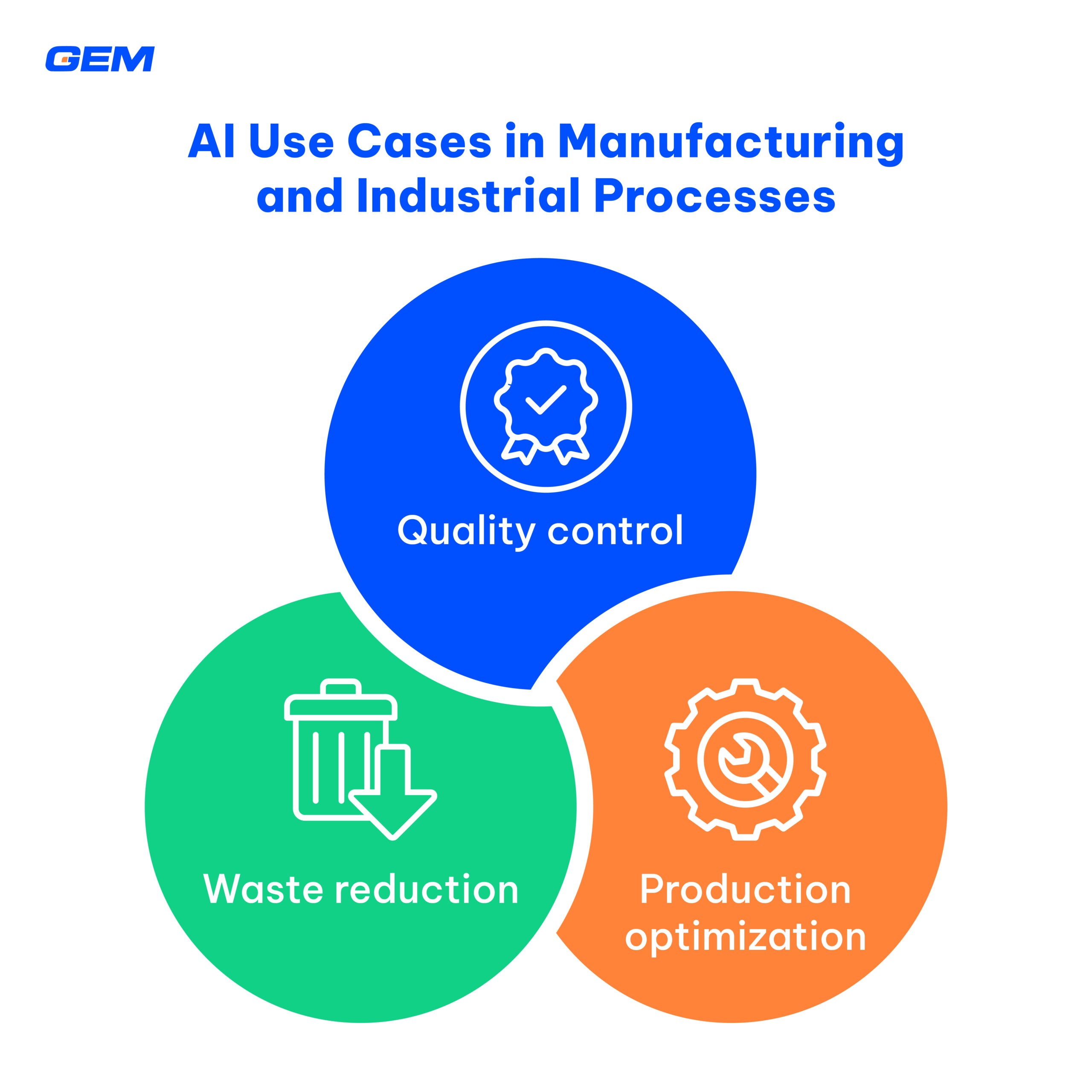
Quality control
Advanced CV stands out as an invaluable tool for quality control. This technology is rapidly evolving and has become adept at identifying even the most subtle flaws, thereby reducing reliance on human expertise.
In essence, a sensing device captures an image and transmits it to an interpreting device. To be more specific, after being trained on datasets of product defects, CV scans images to detect imperfections such as holes, abrasions, scratches, and other undesired features. As a result, it enhances product quality and durability, elevates customer experience, and reduces a significant amount of wasted products.
Production optimization
AI emerges as a potent force for production optimization. It excels in identifying and rectifying inefficiencies, whether in terms of production volume or energy utilization, leading to substantial reductions in waste and operational expenses. Furthermore, AI-driven robotic assembly lines significantly enhance productivity by mitigating human errors and accelerating production cycles.
In addition, AI aids manufacturers in production planning. Historically, they relied heavily on static Excel files, which proved inadequate in adapting to dynamic factors like supply chain disruptions. Now, the incorporation of AI algorithms into the planning process revolutionizes the approach. It enables manufacturers to automate and continuously adjust their plans in real-time, ensuring nimble responsiveness to changing variables.
Waste reduction
As the focus on sustainable manufacturing intensifies, waste reduction emerges as a top priority for manufacturers, with AI playing a pivotal role in this crucial endeavor.
AI can be a valuable asset for researching and developing novel materials that possess desirable qualities while remaining completely reusable or biodegradable. Furthermore, it can aid manufacturers in optimizing resource utilization to minimize waste.
Manufacturers can employ AI for effective material treatment on the production line, alongside the reduction of downtime through preventative maintenance, as previously mentioned. This is particularly significant because a substantial portion of industrial waste comprises subpar products unfit for market use, and prolonged downtimes can result in periodic declines in product quality.
Closing remark
Embracing innovation is the key to staying relevant in this rapidly evolving landscape. The AI use cases mentioned above are just a glimpse into the boundless possibilities that AI offers. Let’s continue to harness its power, push boundaries, and shape a future where technology intertwines seamlessly with progress and possibility.
Are you looking for a trustworthy AI development company?
GEM offers dynamic AI-drive solution development to enable greater revenue and boosted productivity across industries. Our AI service list expands across four branches: Computer vision, Character recognition, Natural language processing, and Predictive recommendation systems. We leverage the power of AI to tailor scalable and efficient solutions that address your unique pain points.
Looking to integrate AI into your digital strategy? AI Agency by GEM Corporation delivers scalable, intelligent solutions tailored to your business goals. Let’s turn your vision into reality.
For faster, let’s connect via the form below!


